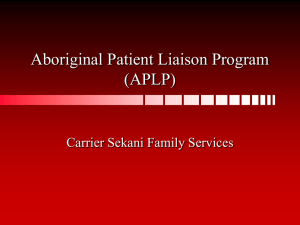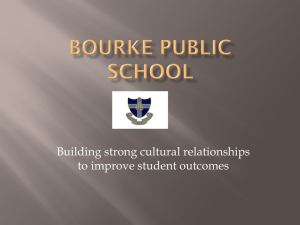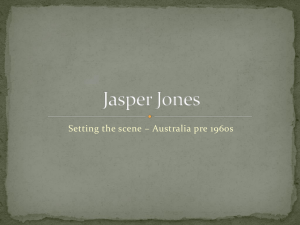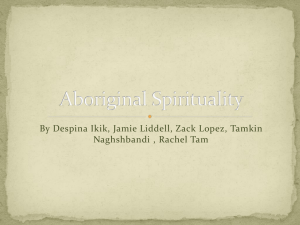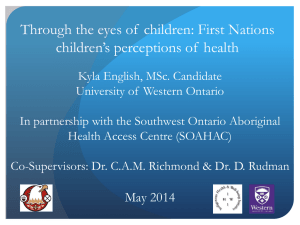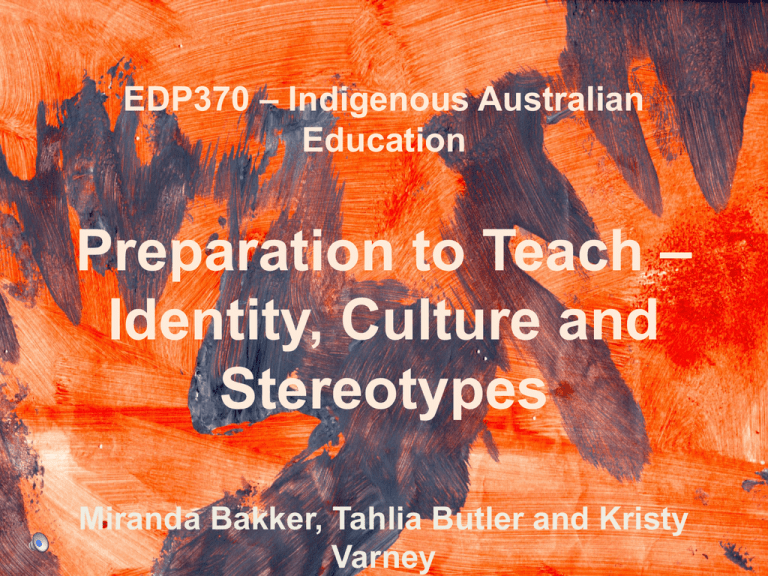
Assignment 1 – Group Teaching
EDP370 –Presentation
Indigenous Australian
Education
Preparation to Teach –
Identity, Culture and
Stereotypes
Miranda Bakker, Tahlia Butler and Kristy
Varney
Overview
.
Identity
Culture
Stereotypes
Social Interaction
Teachers must –
• Provide a safe environment that
values each student’s culture and
one that is safe (Bonney, 2012).
This will • Contribute to the formation of
student’s identity and allow them to
perform to the best of their ability.
Students are –
• More engaged in learning if it is
culturally protected and does not
portray negative stereotypes
(Bonney, 2012).
Identity
- Ascribed
- Achieved
•
•
•
•
•
•
•
Aboriginal people’s identity is the connection
between family and the land (Bonney, 2012).
Individuals look to other influential people, when forming their identity.
The process of perceiving messages holds the potential risk of negativity from others
(Groome, 1995).
Perceptions are influenced by others.
E.g. Family, society, friends, peers and schools.
Aboriginal children they may assume various identities for different situations E.g. Acting
like the majority of children at school and then their Aboriginal identity at home (Groome,
1995).
Society plays an influential role on the formation of identity but it can also enforce fixed
identities on members of society.
The formation of identity is influenced by one’s experience at school as Phillip Wexler states
“All of school life, for the students, centres around the daily project of establishing a social
identity” (Groome, 1995).
Identity continued
••
••
••
••
Different
social situations
alterto
perceptions
of experiences
in forming
identity.
Promote
family
life discussion
ensure a (Harrison,
positive
sense
ofand
self assist
(Bonney,
2012).
Teachers
must
understand
that
Aboriginal
children’s
aim
in
the
classroom
is to
“maintain
a
coherent
and
stable
identity”
2009).
The
approach
taken
by
Aboriginal
children
in
the
classroom
can
be
very
different
from
other
children.
E.g.
When
answering
questions,
speaking
out
aloud
and
making
mistakes
(Harrison,
2009).
Aboriginal
children
are
concerned
about
being
shamed
or
embarrassed
but
they
may
over time
feeland
comfortable
to
contribute
(Harrison,
2009).
Aboriginal
children
will
also
search
for
support
from
other
influences
they
feel
comfortable
with
trust.
E.g.
Children
at
school
(Harrison,
2009).
Education
will
make
Aboriginal
students
feel
successful
which
will
in
turn
become
part
of
their
identity
(Harrison,
2009).
An Aboriginal
studies
that
involves the
entiretoschool
and of
highlights
Aboriginal
culture
willprogram
encourage
Aboriginal
students
be proud
their the
identity.
Culture
••
••
•
•interactions
have
combination
oflive
behaviours,
values,
beliefs,
strategies
andaof
attitudes
available
to
them
develop
certain
patterns
in1995).
how
they
and
assist
in
social
situations
(Groome,
••own Individuals
Ongoing
process
development,
change
andtosocial
throughout
their
lives
(Bonney,
2012).
Consistent
influences
e.g.
media
and
the
individual’s
roles
and
responsibilities
(Bonney,
2012).
There
athe
variety
of
cultural
patterns
demonstrated
by
Aboriginal
people
at
any are
point
in
time
(Groome,
1995). being
In
the
past
belief
to
teach
Aboriginal
children
effectively
was
the
approach
of
“bi-cultural”
(Groome,
1995).
Teachers
must
understand
they
need
to
treat
and
meet
individual
student
requirements
(Groome,
1995).
This
is
vital
as
today
classrooms
consist
of
students
from
numerous
cultures
and
ethnic
groups.
When
teachers
have knowledgeregarding
of their students
cultural
practices and
styles
it
can
elevate
misunderstandings
behaviours,
communication
and
learning
(Bonney,
2012).
Stereotypes
•theOxfam
(n.d.) describes stereotypes as
following:
A
generalised
perception
of first
impressions
about
race or sex
(Oxfam, n.d)
-- Judging
with
the
eyes
An
overestimated
conception,
opinion
or hard
imageto alter (Oxfam, n.d)
- Incomplete
and
inaccurate
beliefs
can be
For
example
all
Aboriginal
people
smoke
and
drink
and
sniff
• Non-Aboriginal
IMPORTANT:
Prejudice
and
racism
are
derived
from
stereotypes.
Stereotypes
can
impact(Oxfam,
a person’s
identity,
level
of education,
success,
health,
community
involvement
and
feelings
andpetrol.
views of
people
2007).
Stereotypes continued
• Perceptual stereotypes relate to the physical image of Aboriginal people, that
if a person is not dark-skinned and wide-nosed then they are not a “real”
Aboriginal (Walker, 1993). A “real” Aboriginal is considered to be an individual
that is living the traditional lifestyle (tribal) and is full-blood (Walker, 1993).
• Education system must teach the positive aspects of Aboriginal history and
culture to avoid negative stereotypes of the Aboriginal culture developing
within society.
• The goal of the NSW Aboriginal Education and Training manual, is to have the
outcomes of Aboriginal students be better or the same as the majority of the
student population by 2012 (Reconciliaction Network, 2007).
• It is essential that teachers do not stereotype all Aboriginal students to have a
preference for working in groups and do not answer questions (Harrison,
2011).
• May be preferred for some students, but it will not engage and meet all
individual needs.
• Teachers must treat all students individually to ensure all the needs of all
students are met.
Pedagogical ideas
•
Always place a strong emphasis on working with what students bring to the
classroom such as, life-world interests and knowledge (Marsh, 2008).
•
Where possible, allow Aboriginal students to work in groups (Harrison, 2011).
•
Allow time for Aboriginal students to read without correction (Harrison, 2011).
•
Always incorporate time in lessons to model and scaffold for Aboriginal
children (Harrison, 2011).
•
Plan activities where the result is self evident instantly (Harrison, 2011).
•
Use role-play to provide students empathy for different cultures (Marsh, 2008).
•
Use media examples to highlight undesirable
bias and discrimination. (Marsh, 2008).
•
Recognise the importance of matching
pedagogy and methodology to the leaner's
needs.
••
••
••
••
••
••
•
Strategies
Ensure
set
tasks
are attainable
and build
upon
students’
current
skill
levels
(Marsh,
2008).
Create
athat
non-judgemental
environment
(Marsh,
2008).
Encourage
students
to
assume
more
personal
responsibility
for
goal
setting
(Marsh,
2008).
Respect
the ethnic
racial
backgrounds
students
by
encouraging
andand
supporting
them (Marsh,
2008). in character
When
asking
questions,
adjust
wait-time
inofconsideration
to diverse
needs of students.
Use
culturally
respectful
and
responsive
approaches
education.
Encourage
students
to
be
open
and
willing
to
evaluate
their
values
(Marsh,
Understand
that
Aboriginal
students
may
not
make
eye
contact
this
doesto2008).
not
mean
they are
not
listening
(Healy,
2008)
Start
the
class
withoverbear
a quiet
reading
to allow
the
aboriginal
students
come
in dribs
and
drabs
– don’t
them
inlesson
authority
(Harrison,
2011). answers
Avoid
direct
questions,
instead
offer
the
students
some
possible
or
direct
questions
to
the
entire
class
rather
than
individuals
(Harrison,
2011).
Ask
students
to share
their
answer withthe
a partner
rather than the whole class.
Teachers
must
care
in ainterpreting
motivations
students
(Harrison,
2011).
Always take
ontake
the role
of
facilitator (Craven,
1999) and interpretations of Aboriginal
Activities
••
•
Provide
opportunities
for
students
to examine
in depth, particular
beliefs
point
ofactivities.
view
relating
to
cultures
(Marsh,
2008).
Ensure
students
from
different
cultures
have
opportunities
to workvalues,
with others
in and
small
group
Things
to
consider
when
planning
activities
for
aboriginal students;
–
Learning
by
observation
–
Learning
by
personal
trail
an
error
–
Learning
in real life
activities
–
Context
specific
learning
–
Learning
is
person
orientated
rather
information orientated
–
The
group
is
more
important
than
thethan
individual
–
Learning
is
holistic
–
Learning
on
visualinstruments
and spatial skills (Healy, 2008).
Examples
ofrelies
some
activities:
•• Playing
indigenous
Indigenous
dance
movements
* Bush survival skills
• Indigenous style artworks
Lesson Culture, Identity and Stereotypes – “What Makes Me”
Year 5
Date
01/03/2013
Time 9:00am Duration: 3 hrs approx/on going
General Capabilities:
Personal and Social Capability – Social Awareness
Intercultural Understanding – Recognising Culture and Developing Respect
Outcomes/Objectives
Acknowledge
the
culture,
and
attitudes
with
which
their
peers
identify.
•Intended
Identify
and
describe
the
various
groups
to
which
they
Describe
ways
that
diversity
presents
opportunities
for
new
experiences
and
understandings
Health
and
Physical
Education
-values
Personal
“Identity
is influenced
byand
personality
traits,
responses
inbelong
aprotocols
variety
ofpromote
social
contexts,
responsibilities
and
accomplishments
Positive
interpersonal
behaviours
anddevelopment
respecting
cultural
effective
interactions
and
relationships
inasymmetrical
groups”
(QSA,
2007)
The
Arts
–Learning
Visual
Arts
“Curved,
angular,
symmetrical,
and
overlapping
shapes
are
used
to2007)
create
balance,
contrast
and
patterns
Texture
creates
contrast
patterns
using
lines,
rubbings
and
markings”
(QSA,
Method of achieving outcomes/strategies
Introduction
(20excite
mins):students 1.
and
Introduce
topic
through
a“Murkurtu,
continued
examination
ofWhat
Aboriginal
Artwork
PPT.PPT.
-Engage
Exploring
and
describing
feelings
2.
Show
example
of
artwork
2010”,
4th
slide
onetc.
Aboriginal
Artwork
Why
is
this
more
than
just
a poles
painting
to the
sisters?
does
it
represent?
3. people
Discuss to
significance
of
Totem
around
the
world.
Used
by various
nationalities
and groups of
represent
their
traditions,
ancestors,
families
Body
(Approx
2task
hrs):and purpose to students
1.
Explain
the
2.
Cultural
references
- community/cultural
celebrations
Christmas,
Birthdays,
International
3.
Written
listclippings,
of whotoand
whatimages,
is these
important
to them
e.g.e.g.
sports,
Australia,
family,
lent,
birth e.g.
of sister
4.
Visual
brainstorm
represent
important
aspects.
Collation
of images
and
material
magazine
internet
symbols
5.
Investigation
and
exploration/research
of
how
to
represent
these
e.g.
coat
of
arms,
pictures
of
sister
6.
Drawing/collage
of
“My
World”
visual
representations
as
a
plan
for
totem
pole.
7. material.
Create “What
Makes Me”boxes,
Totemsand,
Pole.scissors,
Joining, hot
folding,
carving and manipulation of
e.g. cardboard,
gluemoulding,
guns.
Conclusion (Approx 45 mins):
Review, Reflect and Respond on personal and peer Totem Poles
1. Review and reflect how artworks may be ambiguous in their form, content and
meaning as they are subject to different representations and interpretations.
2. Critically reflect upon own and peer work - what they value and why?
3. Review and discuss why the totem poles are successful representations of selfidentity
4. Respond to the creation of each totem pole. Discuss the opportunities and
experiences provided.
Questions to Ask
•
•
•
•
What is our identity?
How does this create our culture?
Why is it important to consider other people’s culture?
How can we value the diversity of our classroom?
References
Please find reference list attached as
“Notes”




